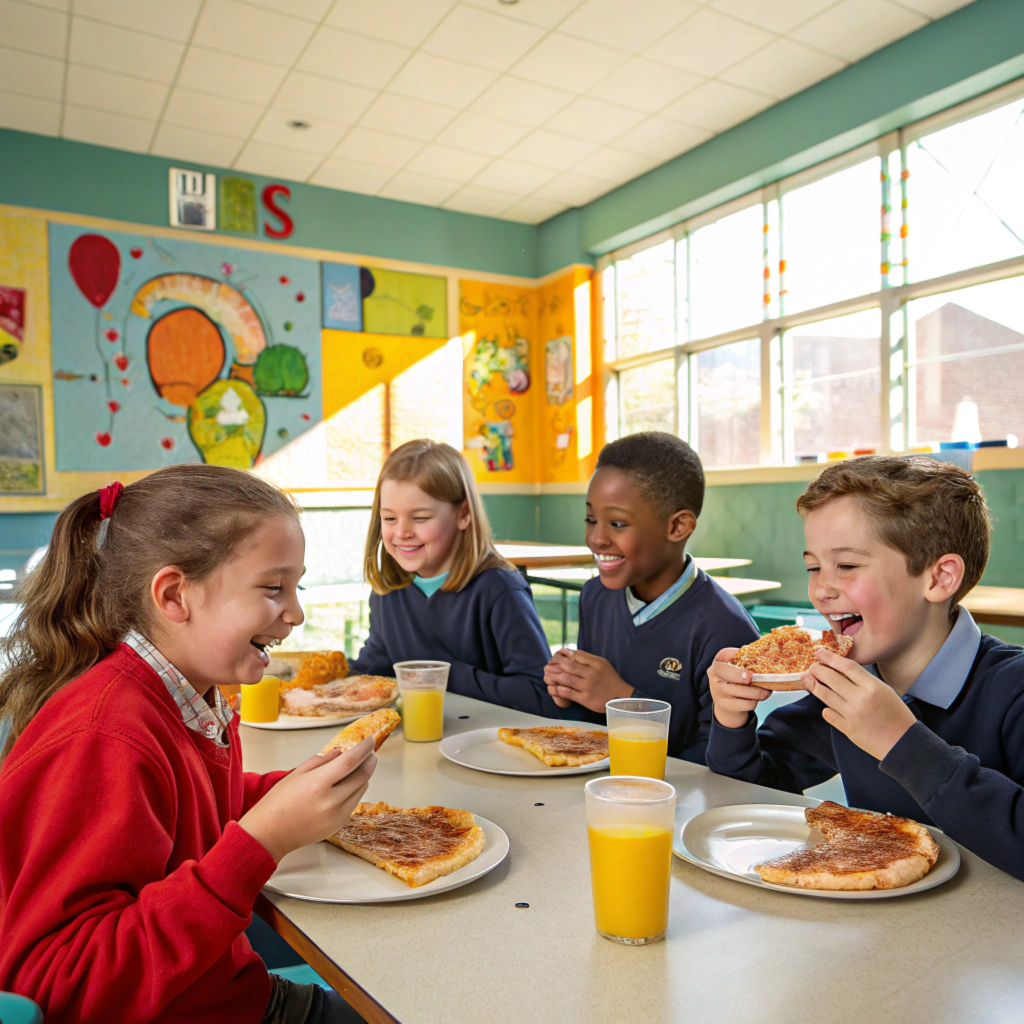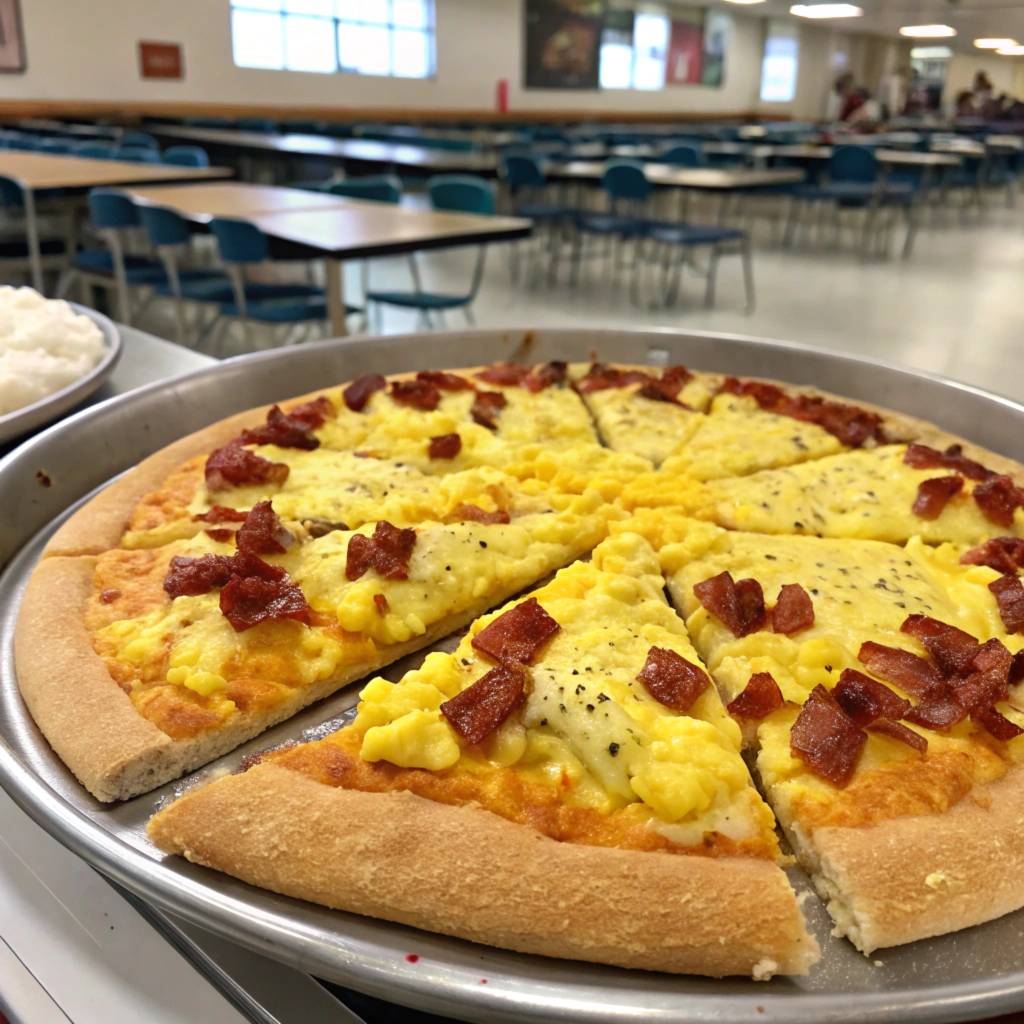
What Is Breakfast Pizza?
Breakfast pizza is a creative twist on a classic favorite, designed to combine the flavors and ingredients of a traditional breakfast into a pizza format. It typically features a base made from whole-grain crusts or flatbreads, topped with breakfast staples like eggs, cheese, and lean proteins such as sausage or ham. For added nutrition and appeal, vegetables or even sweet toppings like yogurt and fruits can be included.
Why Is Breakfast Pizza Perfect ?
Combining Nutrition and Appeal
Breakfast pizza is both nutritious and appealing, making it an ideal option for school cafeterias. Its combination of whole grains, protein, and vegetables ensures students receive essential nutrients to fuel their day. The customizable nature of the dish allows it to cater to a variety of dietary needs and preferences, increasing its popularity among students.
Encouraging Students to Eat Breakfast
Breakfast is the most important meal of the day, but many students skip it. Offering a fun, pizza-inspired option encourages participation in school breakfast programs. Breakfast pizza’s familiarity and exciting presentation make it a hit with kids, while its nutritional profile satisfies school meal requirements.
Nutritional Benefits o for Schools
Key Nutrients to Include
Protein from Eggs, Cheese, and Meat
Protein is essential for growth, development, and maintaining energy throughout the day. Breakfast pizza often includes:
- Eggs: A versatile ingredient rich in protein and essential nutrients like choline.
- Cheese: Provides calcium and protein, supporting bone health and muscle development.
- Lean Meats: Options like turkey sausage or ham offer a flavorful and low-fat protein source.
Whole Grains for Long-Lasting Energy
A whole-grain crust or flatbread base is an excellent source of fiber and complex carbohydrates. These nutrients:
- Help stabilize blood sugar levels.
- Provide sustained energy for better focus and performance in class.
- Meet USDA guidelines for whole-grain-rich school meals.
Meeting School Nutrition Guidelines
USDA Requirements for School Breakfast Programs
Breakfast pizza can easily fit into USDA requirements by incorporating:
- At least one serving of whole grains (such as whole-grain crusts).
- Protein-rich toppings like eggs and cheese.
- Vegetables or fruits to fulfill the produce component.
How Breakfast Pizza Fits into Healthy Meal Plans
By balancing macronutrients (carbohydrates, proteins, and fats), breakfast pizza aligns with the dietary needs of school-aged children. Offering customizable toppings ensures that nutritional goals are met while appealing to a wide range of preferences and dietary restrictions.
Ingredients for Making Breakfast Pizza for Schools
Base Options for Breakfast Pizza

Using Whole Grain Crusts for Healthier Options
Whole grain crusts are the foundation of a nutritious breakfast pizza. They provide fiber and essential nutrients while meeting USDA school meal guidelines. Options include:
- Whole Wheat Dough: A classic and versatile choice.
- Flatbread: Easy to prepare and portion for large groups.
- Whole Grain Tortillas: Great for individual-sized pizzas.
Alternative Bases: Flatbreads or English Muffins
For variety and flexibility, consider alternative bases:
- English Muffins: Split into halves for mini breakfast pizzas.
- Bagels: A heartier option that students love.
- Cauliflower Crust: Suitable for gluten-free or low-carb options.
Toppings for a Balanced Breakfast Pizza
Eggs, Cheese, and Vegetables
Toppings should provide a balance of flavors and nutrients:
- Eggs: Scrambled or baked for a rich source of protein.
- Cheese: Use low-fat mozzarella or cheddar for creamy texture and calcium.
- Vegetables: Spinach, bell peppers, and tomatoes add vitamins and color.
Lean Proteins Like Turkey Sausage or Ham
Incorporate lean proteins to keep the meal healthy and satisfying:
- Turkey Sausage: A flavorful, lower-fat alternative to pork sausage.
- Ham: A lean option that pairs well with cheese and vegetables.
- Plant-Based Proteins: For vegetarian options, try tofu crumbles or plant-based sausage.
Creative and Customizable Add-Ins
Incorporating Seasonal or Local Ingredients
Using seasonal vegetables or locally sourced produce enhances flavor and supports community agriculture. Consider ingredients like:
- Fresh herbs for added zest.
- Sweet potatoes or squash for fall-themed pizzas.
Offering Vegetarian or Vegan Options
To cater to diverse dietary needs, include:
- Vegan Cheese: A dairy-free alternative that melts well.
- Plant-Based Toppings: Add mushrooms, avocado slices, or roasted chickpeas for flavor and nutrition.
By focusing on wholesome ingredients, breakfast pizza can meet school nutrition standards while remaining delicious and versatile.
How to Prepare Breakfast Pizza for Large Groups
Preparing breakfast pizza for schools involves scaling recipes, organizing ingredients, and streamlining the cooking process. Here’s how to efficiently make breakfast pizza for large groups while maintaining quality and flavor.
Scaling Recipes for School Cafeterias
Adjusting Ingredients for Bulk Cooking
- Portioning: Calculate portions based on the number of students. A standard 12-inch pizza serves 4–6 students, while mini pizzas or English muffin bases can be portioned individually.
- Ingredient Quantities: Multiply ingredients by the required number of servings. Use bulk-size containers of cheese, eggs, and toppings to simplify preparation.
- Consistency: Ensure dough portions and topping layers are consistent across pizzas for even cooking.
Prepping and Storing Ingredients in Advance
- Dough Preparation: Prepare crusts or flatbreads in advance. Pre-bake them lightly to save time during assembly.
- Topping Storage: Pre-cook and store toppings like scrambled eggs, sausage, and vegetables in airtight containers in the refrigerator.
- Batch Processing: Chop vegetables and measure cheese in bulk to streamline the assembly process.
Step-by-Step Process for Making Breakfast Pizza
Assembling the Pizza
- Spread the Base: Add a light layer of sauce or cheese directly onto the crust.
- Layer Toppings: Evenly distribute eggs, cheese, proteins, and vegetables. Avoid overloading to ensure even cooking.
- Customize: Create variety by offering vegetarian, vegan, or themed options for special occasions.
Baking and Serving Tips
- Baking Temperature: Bake at 375°F–400°F (190°C–200°C) for 10–15 minutes, depending on the size of the pizza.
- Batch Baking: Use multiple oven racks or convection ovens to bake several pizzas at once. Rotate trays halfway through for even browning.
- Serving Efficiency: Slice pizzas ahead of time and use warming trays to keep them hot during serving.
With proper preparation and streamlined processes, breakfast pizza can be served efficiently in large quantities without compromising taste or quality.
Popular Breakfast Pizza Recipes for Schools
Breakfast pizza recipes can be tailored to meet the nutritional needs of students while offering a variety of flavors. Here are some popular options that are sure to please a crowd.
Classic Breakfast Pizza with Eggs and Sausage
How to Make It Appealing to Kids
- Use familiar ingredients like scrambled eggs, sausage crumbles, and a blend of mozzarella and cheddar cheese.
- Cut the pizza into small, easy-to-handle slices for younger students.
- Add a drizzle of ketchup or serve with a side of salsa for extra flavor.
Nutrition Facts for This Option
- High in protein from the eggs and sausage.
- Provides essential calcium and vitamin D from the cheese.
- Meets USDA requirements with a whole-grain crust and a serving of vegetables like diced tomatoes or spinach.
Vegetarian Breakfast Pizza
Adding Spinach, Peppers, and Cheese
- Spread a thin layer of cream cheese or tomato sauce as a base.
- Top with scrambled eggs, sautéed spinach, bell peppers, and shredded mozzarella cheese.
- Sprinkle fresh herbs like basil or parsley for added flavor and appeal.
Adapting for Plant-Based Diets
- Use vegan cheese and egg substitutes like tofu scramble or plant-based eggs.
- Add protein-rich toppings like chickpeas or avocado slices.
Sweet Breakfast Pizza for Variety
Using Fruits, Yogurt, and Honey
- Replace traditional crusts with a whole-grain flatbread or cinnamon roll dough.
- Spread Greek yogurt as the base and top with fresh fruits like berries, banana slices, or apple chunks.
- Drizzle with honey or sprinkle with granola for added texture and sweetness.
Perfect for Special School Events
- Serve during themed breakfast days or celebrations like National School Breakfast Week.
- Offer smaller, individual-sized portions for easy serving at events.
These recipes combine nutrition and flavor, catering to different dietary needs and preferences, making breakfast pizza a versatile and well-loved school meal option.
Tips for Successfully Introducing Breakfast Pizza in Schools
Implementing breakfast pizza as a school meal option requires planning and engagement to ensure its success. Here are practical strategies to make breakfast pizza a hit with students and staff alike.
Engaging Students and Staff

Offering Taste Tests or Free Samples
- Host a “Breakfast Pizza Day” where students can sample different pizza varieties during breakfast hours.
- Allow students to vote for their favorite flavors to include in the regular menu.
Getting Feedback from Students
- Distribute short surveys or use suggestion boxes to gather student input on flavors and toppings.
- Hold classroom discussions about healthy eating and ask students for creative topping ideas.
Working with Food Service Teams
Training Staff to Make and Serve Breakfast Pizza
- Conduct training sessions for cafeteria staff on assembling and baking breakfast pizza efficiently.
- Emphasize portion control and presentation to maintain consistency across servings.
Simplifying the Cooking and Serving Process
- Use pre-made crusts or bases to reduce preparation time.
- Pre-portion ingredients to streamline the assembly process during busy mornings.
- Serve pizza slices with sides like fruit cups or milk to create a balanced meal.
By involving students in the process and ensuring staff are well-prepared, breakfast pizza can quickly become a popular and well-executed addition to school menus.
Addressing Common Challenges with Breakfast Pizza in Schools
Introducing breakfast pizza to school menus can come with challenges. Here’s how to overcome common hurdles to ensure the program runs smoothly and meets its goals.
Ensuring Affordability for School Budgets
Finding Cost-Effective Ingredients
- Bulk Purchasing: Source ingredients like cheese, eggs, and whole-grain crusts in bulk to reduce costs.
- Local Partnerships: Work with local farms or suppliers for discounted rates on fresh produce and dairy.
- Substituting Ingredients: Use affordable options like turkey sausage or frozen vegetables to keep costs manageable without compromising quality.
Reducing Waste in Bulk Preparation
- Prepare only the quantities needed based on daily participation numbers to minimize overproduction.
- Use leftover pizza creatively, such as incorporating it into breakfast casseroles or reheating for later use.
- Train staff to measure and portion toppings accurately to avoid overuse and waste.
Accommodating Dietary Restrictions
Gluten-Free and Dairy-Free Options
- Gluten-Free Crusts: Offer pre-made gluten-free crusts or cauliflower bases to meet dietary needs.
- Dairy-Free Cheese: Use plant-based cheese alternatives for students with lactose intolerance or dairy allergies.
Ensuring Allergen-Free Meals
- Clearly label all ingredients and identify potential allergens like nuts or gluten.
- Prepare allergen-free pizzas in a separate area to avoid cross-contamination.
- Train staff on food safety protocols to ensure allergen-free meals are handled appropriately.
By addressing these challenges proactively, schools can successfully introduce breakfast pizza while meeting nutritional guidelines and accommodating diverse student needs.
FAQs About Breakfast Pizza for Schools
Why Is Breakfast Pizza a Good Option for Schools?
Breakfast pizza combines nutrition and appeal, making it ideal for schools. It provides balanced nutrients like protein, whole grains, and vegetables while offering a fun and familiar format that encourages students to eat breakfast.
Can Breakfast Pizza Meet USDA School Nutrition Guidelines?
Yes, breakfast pizza can meet USDA requirements by using:
- Whole-grain crusts to fulfill the grain component.
- Protein-rich toppings like eggs and cheese.
- Vegetables or fruits to meet produce requirements.
How Can Schools Accommodate Dietary Restrictions with Breakfast Pizza?
Schools can easily adapt breakfast pizza to meet dietary needs:
- Use gluten-free crusts or cauliflower bases for gluten-sensitive students.
- Offer vegan or dairy-free cheese and plant-based proteins for special diets.
- Clearly label allergen-free options to ensure safety for all students.
What Are Some Kid-Friendly Breakfast Pizza Toppings?
To make breakfast pizza appealing to kids, consider using:
- Scrambled eggs, cheddar cheese, and turkey sausage for familiar flavors.
- Sweet options like Greek yogurt, fresh fruit, and a drizzle of honey.
- Fun shapes or mini pizza portions for easier handling.
How Can Schools Make Breakfast Pizza Affordable?
Schools can keep costs low by:
- Buying ingredients like cheese, eggs, and crusts in bulk.
- Partnering with local farms for fresh, cost-effective produce.
- Using versatile toppings that can be repurposed for other meals.
Can Breakfast Pizza Be Prepared in Advance?
Yes, breakfast pizza can be prepped ahead:
- Pre-bake crusts and store them for assembly the next morning.
- Prepare and refrigerate toppings like scrambled eggs and cooked sausage.
- Assemble and bake pizzas in the morning for freshness and efficiency.
By addressing these common questions, schools can confidently integrate breakfast pizza into their meal programs while meeting the needs of students and staff. Let me know if there’s anything you’d like to expand on!